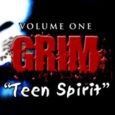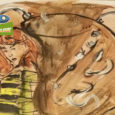
King Jackson
Happy week after Memorial Day! That’s a thing, right? I’m making it a thing, and celebrating by telling you about Quirk Books’ new title Presidential Campaign Posters: Two Hundred Years of Election Art. I thought this book was a joke when I first saw it, considering the cover prominently displays an image of Gerald Ford dressed like the Fonz; however it is all too real and the surprises don’t begin or end with Ford.
It’s not just the subject matter that makes this book unique, but also the format. As opposed to the typically stout mass-market paperbacks that make up most of the history section at any bookstore, Presidential Campaign Posters is tall and 208 pages long. It begins with Andrew Jackson pictured as a King by his opponents and ends with Obama’s “Hope” campaign. Each of the posters is perforated so it can easily be removed and framed, however the back includes factual and anecdotal information about the presidential race in which the poster featured. Even if I had the wall space, I prefer to preserve the book the way it is. Not only is each poster a gorgeous, high-quality re-print direct from the Library of Congress, but the story that the posters tell from beginning to end reveals how little has changed in our country’s politics in the last two centuries.
Really, when I first read about this book I thought it was a clever trick; some kind of satirical commentary on each president’s reign. I thought there was no way posters as ridiculous as President Carter dressed like Jesus could be real until I was flipping through this book and reading the stories that went along with each image.

Another very real Gem from our history
What fascinates me even more than the posters themselves is the narrative that they spell out about our history. Presidential elects have always tried to appeal to the common man, and no smear has ever been too low.
This book is credited to “Library of Congress” as the author. I’m a dramaturg, so I love research and love seeing it organized in interesting and innovative ways. My press copy of Presidential Campaign Posters arrived along with an interview with the Library of Congress’ Publishing Director W. Ralph Eubanks, and I wish that the interview had been included in the book itself. Eubanks specifically talks about how television changed the way that campaign posters were composed, and while the book touches on this element of campaign races it only does so briefly. Eubanks explains the broad effects: “Whereas early campaign posters were vehicles for publicizing candidates’ political messages, the post-1960 posters were simply ways to get the names of the candidates in the minds of the voters, with political messages communicated via television commercials and the news media.”
If I had a rating system of five stars, this book would get all five. It took a subject in which I was only mildly interested, and made me pour over pages and pages without realizing how much time had passed. Not only that, it’s a brilliant piece of dramaturgy and a fascinating way to present what could very well have been dry, dusty material. Highly recommended for…pretty much anyone who can read.















